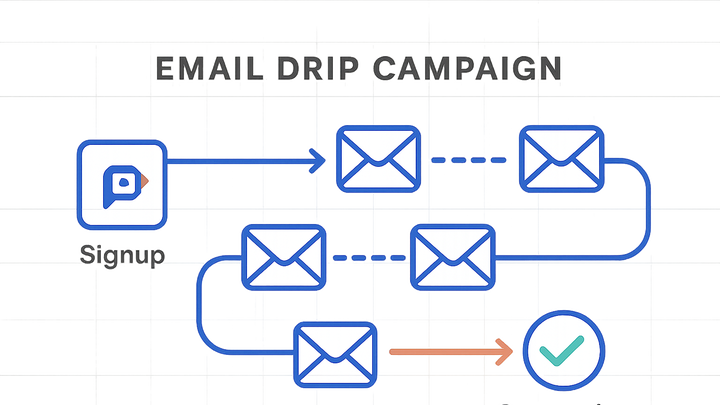Published on 2025-06-29T20:02:59Z
What is a Drip Campaign? Examples for CRO, UX, and SEO
Drip Campaigns are a series of automated, scheduled messages delivered to prospects or customers over time. They nurture leads through the buyer journey by providing relevant content at predefined intervals, enhancing both conversion rate optimization (CRO) and user experience (UX). For SEO, drip campaigns can indirectly improve engagement signals like click-through rates and dwell time, which can positively impact rankings.
SaaS tools like Prevue.me can help you analyze and optimize each touchpoint for accessibility, UX, and SEO performance by offering actionable critiques. By integrating drip campaigns into your marketing strategy, you ensure consistent communication, build trust, and guide users towards conversion milestones. Well-designed drip sequences unlock sustained engagement and higher ROI over time.
Drip campaign
Automated series of timed messages that nurture leads and improve CRO, UX, and SEO by delivering relevant content throughout the buyer journey.
Why Drip Campaigns Matter in CRO/UX/SEO
Drip campaigns play a pivotal role in optimizing conversion rates, enhancing user experience, and sending positive signals to search engines. They allow marketers to deliver the right message, to the right person, at the right time, increasing engagement and trust over the customer lifecycle.
-
Improved lead nurturing
Drip campaigns guide prospects through the buyer journey with targeted content at each stage, increasing the likelihood of conversion.
- Targeted messaging:
Deliver content tailored to user behavior and preferences to maintain relevance.
- Progressive profiling:
Gradually collect user information over time to enhance personalization without overwhelming new leads.
- Targeted messaging:
-
Enhanced user engagement
Timely, relevant messages keep users engaged with your brand, reducing churn and improving satisfaction.
- Timely touchpoints:
Schedule messages based on user actions or predefined intervals to stay top-of-mind.
- Personalization:
Use dynamic content and user data to create a more personalized experience.
- Timely touchpoints:
-
Seo signals
While drip campaigns are primarily email-focused, increased engagement and lower bounce rates can indirectly boost SEO performance.
- Reduced bounce rate:
Engaging email links can drive users to relevant pages, lowering overall site bounce rates.
- Increased dwell time:
Relevant content encourages users to spend more time exploring your site, which search engines view favorably.
- Reduced bounce rate:
Key Components of a Drip Campaign
A successful drip campaign comprises several core components that work together to nurture leads and drive conversions. Understanding these building blocks ensures effective campaign design and execution.
-
Triggers
Triggers determine when a drip campaign message is sent.
- User behavior:
Actions such as sign-ups, page visits, or clicks can initiate a drip sequence.
- Time-based:
Messages sent at set intervals after a user action or on specific dates ensure consistent communication.
- User behavior:
-
Email sequence
The structure and content of your emails guide recipients through the conversion funnel.
- Welcome email:
First interaction that sets expectations and introduces your brand or product.
- Follow-up content:
Educational or promotional content that addresses user needs at each stage.
- Welcome email:
-
Segmentation
Categorizing your audience ensures each subscriber receives the most relevant messages.
- Demographic segmentation:
Group users by age, location, or other demographics for tailored messaging.
- Behavioral segmentation:
Segment based on user actions, such as past purchases or website activity.
- Demographic segmentation:
Examples of Drip Campaigns
Real-world examples illustrate how drip campaigns can be applied across different scenarios. Below are common use cases, including how SaaS platforms like prevue.me support drip campaign optimization.
-
Prevue.me onboarding campaign
Using prevue.me’s insights, create a drip sequence that welcomes new users and highlights key features based on accessibility and UX critiques.
- Welcome & setup guide:
Introduce users to the platform and guide them through initial setup steps.
- Feature highlights:
Showcase the most impactful features identified by prevue.me for improving CRO and UX.
- Action reminder:
Prompt users to complete profile information or start their first audit.
- Welcome & setup guide:
-
E-commerce abandonment campaign
Recover lost sales by reminding visitors of abandoned carts and providing incentives.
- Cart reminder:
Send an email listing the items left behind with a clear call-to-action.
- Social proof:
Include reviews or testimonials to reassure and encourage purchase.
- Cart reminder:
-
Lead magnet follow-up
Deliver promised content and nurture leads with relevant resource recommendations.
- Content delivery:
Automatically send the eBook, guide, or checklist that users signed up for.
- Further resources:
Suggest related blog posts, webinars, or tools to deepen engagement.
- Content delivery:
Best Practices and Optimization
Continuous optimization is essential for maximizing the impact of drip campaigns. This section covers proven strategies, key metrics, and testing approaches to refine your campaigns.
-
A/b testing
Use A/B tests to optimize subject lines, email copy, and send times.
- Subject line tests:
Experiment with different headlines to maximize open rates.
- Send time optimization:
Determine the best times to send emails for your audience.
- Subject line tests:
-
Personalization & dynamic content
Tailor email content using user data and dynamic blocks.
- Merge tags:
Insert user-specific information, like names or past purchase details.
- Conditional content:
Show different blocks based on user attributes or behavior.
- Merge tags:
-
Performance monitoring
Track key metrics to evaluate and refine campaign effectiveness.
- Open rate:
Measures how many recipients opened your emails.
- Click-through rate (ctr):
Indicates the percentage of clicks on links within your emails.
- Conversion rate:
Tracks how many recipients completed the desired action.
- Open rate:
